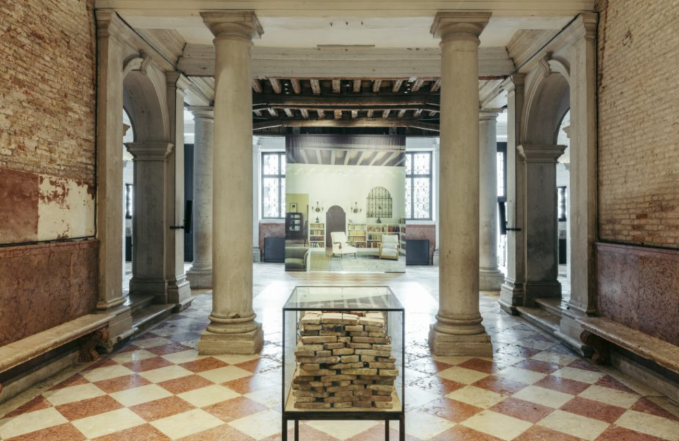This exhibition at the Fondazione Prada in Venice, discusses exile, escape and retreat in physical and psychological places. These are explained rather rigorously through art that prevails the lives of philosophers, Heidegger (1889-1976), Adorno and Wittgenstein (1889- 1951). The exhibition was spurred on due to these philosopher’s own need for escapism of daily routine and structure. Heidegger for example spent most of his years shut away in a hut in the Black Forest in Germany. This may seem like a heavy exhibition and actually, rather unappealing. But the show is actually about how contemporary artists who have experimented around their ideas to find peace in body and soul within the hectic structured world.

The ground floor of the exhibition is dedicated to Adorno, the philosopher connected to Walter Benjamin and Ernst Bloch. These thinkers used Freud and Marx theories to analysed the modern world. He extensivly critiqued fascism and its culture through his books such as, ‘Dialectic of Enlightenment’. Adorno escaped Nazi Germany firstly to Merton Collage, Oxford and then to America. His exile is explored through photographs of remote structures and photos of his meeting places of leftists in LA. Susan Philipsz’s compositional work fills the room with her music ’14 ways to describe rain’. It enhances a eerie feeling of isolation of what it felt like to be in Adorno’s position.
In the piano mobile of the palazzo, Heidegger and Wittgenstein’s isolation is portrayed through two physical structures of their huts. They are both 80% to scale yet so surprising how small they are. In Heidegger’s it is fascinating to walk through the tiny rooms in which he would have lived in. He would have preseumably written his most famous book ‘Being and Time’ there. In the book, he asks the question of what it is to be. No wonder he lived in isolation!! Far too serious for me. Photos are placed on the walls of Heidegger and his life there with his acedemic friends. It looks cosy and festive. But you question what such isolation must be like with no one there. A film called Die Hut in the cinema room underlines this. The narrator imagines Heidegger and his wife sitting in the cold, whilst he works and she knits him his winter socks. Today, the hut is owned by the Heidegger family and is a place of pilgrimage for his readers. Although I definetly wouldn’t want to, his long standing relationship with the Nazi party is not cool.
As for Wittgenstein’s hut, the viewer can only peer in through the window. He built it from scratch with his own hands. Unfortunately the structure does not stand today perhaps because of its fragility. Inside is a built fireplace and his walking stick. Wittgenstein turned his back on his former life coming from one of the richest families in Europe by donating his entire inheritance to artists, writers and some family to structure his life around his philosophical writing.
The structures that are placed and created around the exhibition not only entail the philosophers isolation and retreat, they shelter their ideas and ethos which they created at these times. Hence, structure can act as a symbol for so much more.

Although opposing in thought, these philosophers seeked the same solitude. That is what this exhibition brings to mind, how such thinkers needed escapism to structure their thought. Gerhard Ritcher’s paintings from remote landscapes are positioned alongside medieval paintings of Saint Jerome (who spent most of his life in the desert translating the Bible into Latin) depict ways of other intellectual artists seeking the sensation of solitude.
The title of the show really sums it all up. ‘Machines a penser’ refers to Le Corbusier’s saying a house should be a machine for living. Physically Heidegger and Wittgenstein lived this way however Adorno metaphorically emboided this term to sculpt his own life.
